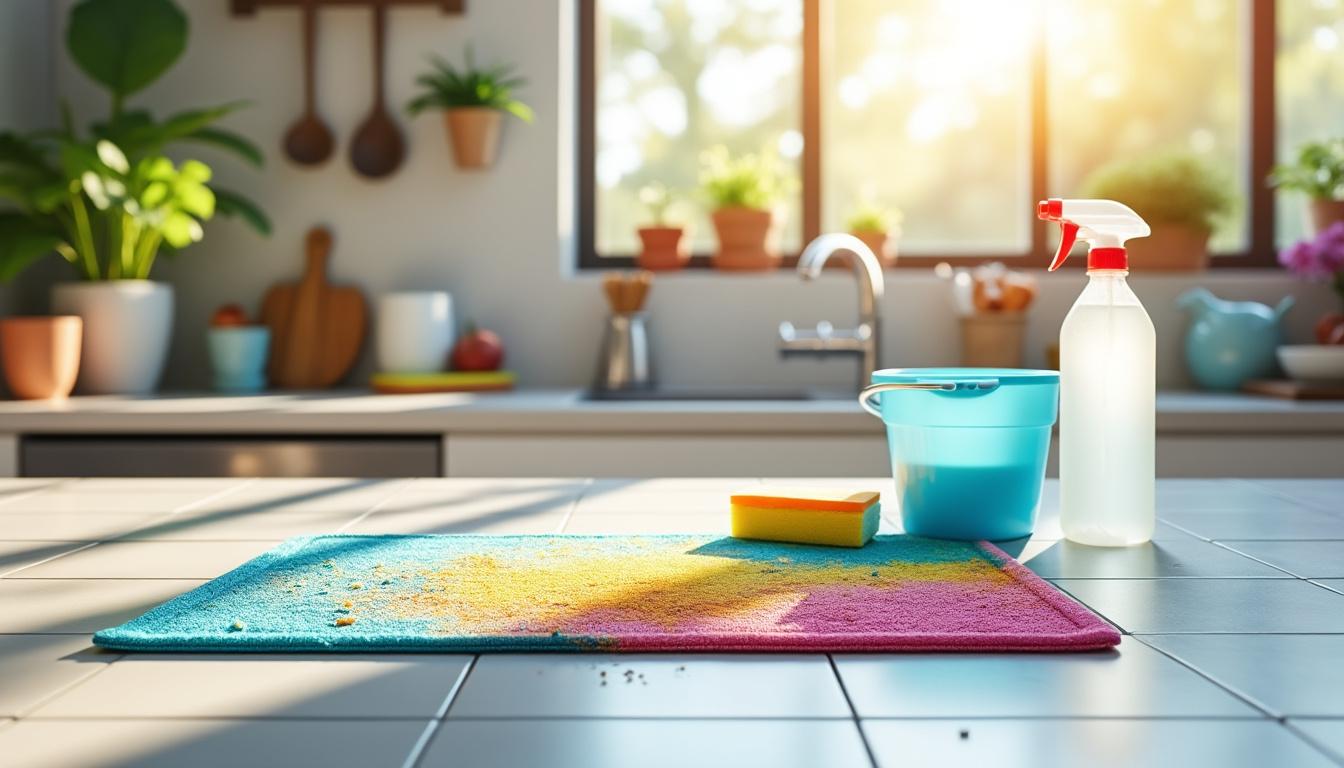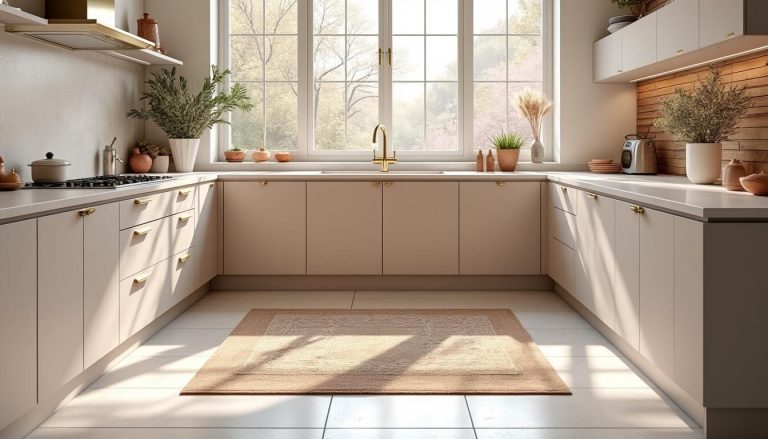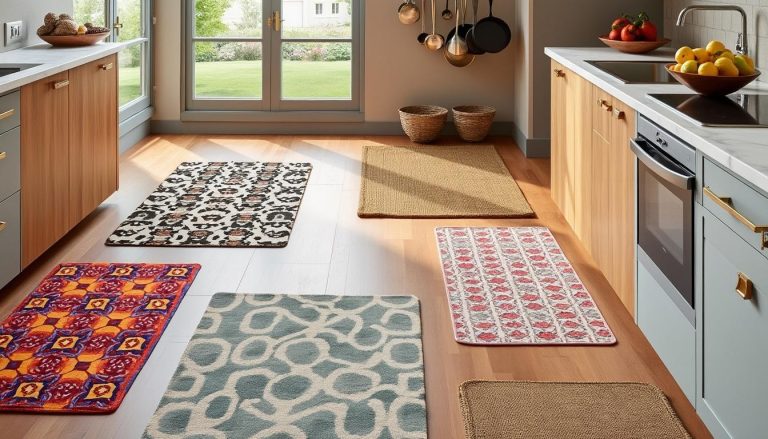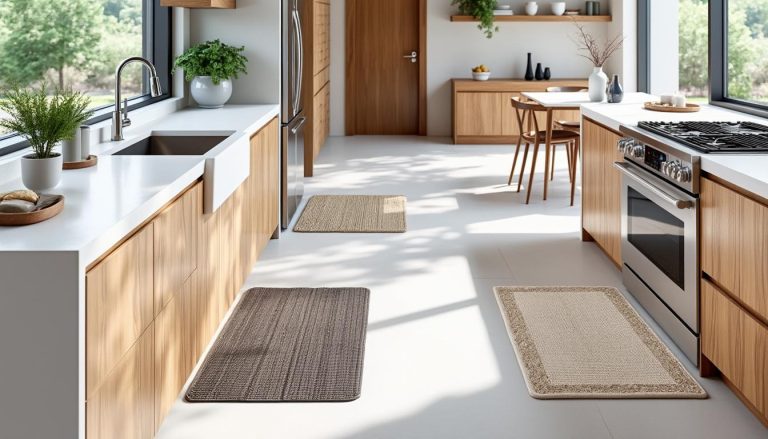Picture this: you step into your kitchen after a busy day, ready to chop up veggies or bake that perfect batch of Nana’s cookies. But your kitchen mat? It looks like it’s seen one too many spills, crumbs, and maybe even the odd splash of maple syrup. Keeping kitchen mats clean isn’t just about looks—it’s about hygiene, safety, and comfort as you cook away in your favourite spot at home. In Canada, where home-cooked meals are a cherished tradition, maintaining a tidy kitchen is almost a reflex, and kitchen mats play a starring role. But they can get grimy from food particles, grease, and bacterial growth, turning into a hotspot for nasty germs if neglected. From rubber mats at Toronto’s bustling condos to plush anti-fatigue mats in cozy Nova Scotia kitchens, every type demands care suited to its material.
Given the ever-changing climate—those snowy, slushy winters in provinces like Quebec and Ontario can make mats damp and slippery—having clean, dry, non-slip kitchen mats is essential for both safety and comfort. This article digs into the best ways to clean your kitchen mats using everyday products you can find at Canadian stores like Canadian Tire, Home Depot Canada, or London Drugs. Whether it’s the trusty Bissell vacuum, a spray of Arm & Hammer baking soda for odors, or the gentle touch of Mrs. Meyer’s multi-surface cleaners, each step guarantees your mats look fresh and last longer. And hey, let’s not forget that a little TLC for your mats means fewer germs on the floor, reducing food contamination risks as per Canadian health standards. So, ready to dive into some practical, home-friendly cleaning advice? Let’s get those mats sparkling again!
Effective Step-by-Step Cleaning Process for Kitchen Mats in Canadian Homes
Cleaning kitchen mats might seem like a chore nobody’s eager to do, but trust me, it’s worth the effort. Not only does it freshen up the heart of your cooking space, but it also prevents slips and potential health hazards—which in Canadian kitchens with lots of foot traffic, is a serious win. The first step is simple but essential: remove the mat and shake off any loose debris. Especially useful after a winter storm with mud and salt tracked inside, a good shake before cleaning keeps the process easier and more effective.
Next, a powerful vacuum cleaner like a Bissell or a Shark is your best friend. Vacuuming removes stubborn crumbs, bits of dried food, and dust deeply embedded in the fibres or grooves. This step ensures your cleaning solution won’t just mix with dirt but actually does its job.
For the actual washing, prepare a mild yet effective cleaning solution: use warm water mixed with a few drops of gentle dish soap or a specialized cleaner like Mrs. Meyer’s multi-surface spray. Harsh chemicals or bleach aren’t recommended here—they can degrade the material and cause discoloration, which is a big no if you want to keep your mats looking pristine.
Grab a soft-bristled brush or a Scotch-Brite scrubber, and gently tackle dirty spots, especially oily stains near the stove area. If your kitchen mat is rubber or anti-fatigue foam, avoid soaking it excessively—too much water can cause damage. Rinse the mat thoroughly with clean water—ideally, using a hose outdoors if you live in warmer months in places like British Columbia. Then, air dry your mat fully to prevent mold or mildew buildup, which can cause nasty smells especially in humid environments like Vancouver.
- 🍁 Remove and shake off loose debris outdoors
- 🍁 Vacuum using a Bissell or Shark vacuum cleaner
- 🍁 Prepare warm water with mild dish soap or Mrs. Meyer’s cleaner
- 🍁 Scrub gently with a soft brush or Scotch-Brite scrubber
- 🍁 Rinse with clean water and air dry completely
| Cleaning Step 🧼 | Recommended Products 🇨🇦 | Tips & Tricks ✨ |
|---|---|---|
| Removing debris | Manual shake, Bissell vacuum | Do this outdoors to avoid mess |
| Cleaning solution prep | Mrs. Meyer’s soap, mild dish detergent | Avoid bleach or harsh chemical cleaners |
| Scrubbing stains | Scotch-Brite scrubber, soft-bristle brush | Focus on high-traffic/greasy spots |
| Rinsing | Clean water, garden hose (recommended in warm seasons) | Avoid soaking anti-fatigue or foam mats |
| Drying | Air drying rack or sunny spot | Make sure mat is fully dry before use |
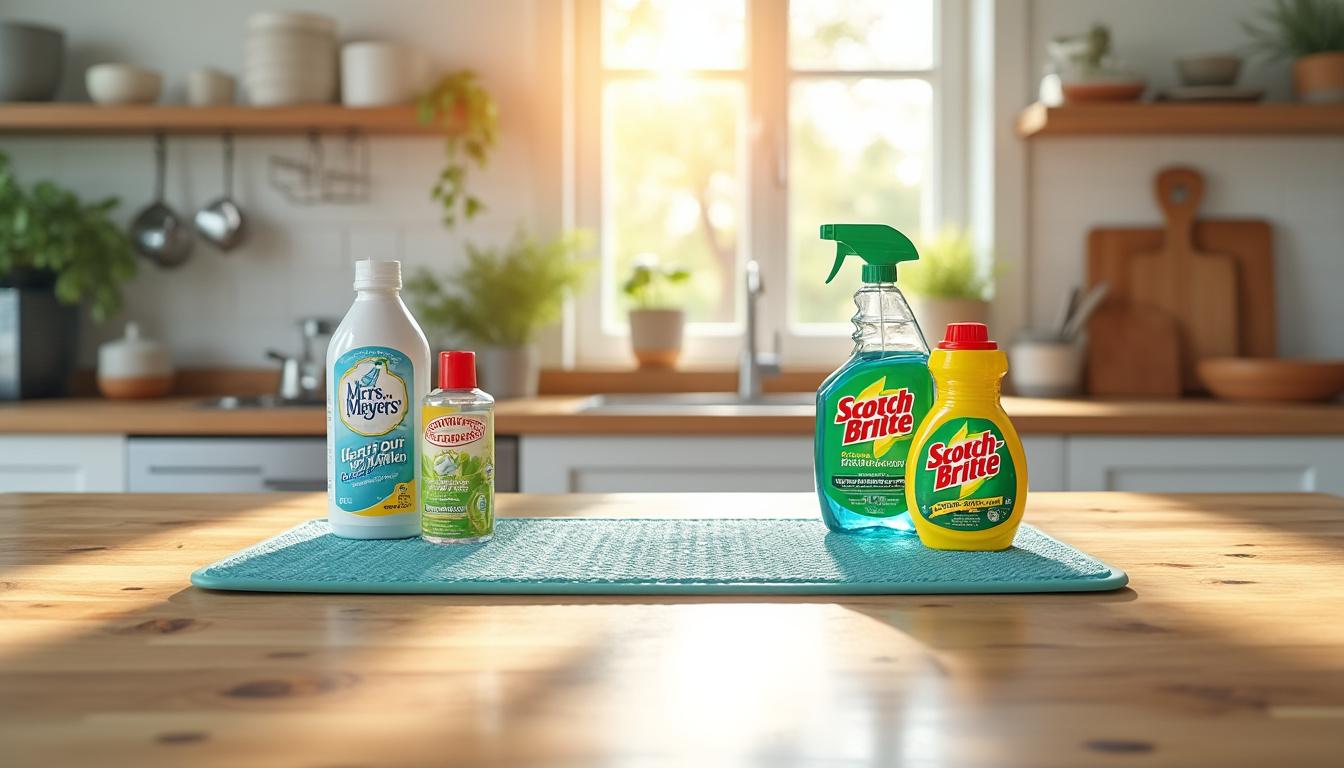
Choosing the Right Cleaning Agents: From OxiClean to Nature’s Miracle for Stains and Odors
When it comes to cleaning kitchen mats, it’s not just about scrubbing – the choice of cleaning agents can make all the difference. In Canadian households, products like OxiClean and Arm & Hammer baking soda have become go-to staples for tackling tough stains and eliminating odors effectively and safely. Each offers a distinct advantage, especially for stubborn marks left from pancake syrup spills during winter breakfast or accidental red wine drops from dinner parties in Montréal.
OxiClean is a powerful yet environmentally conscious oxygen-based cleaner popular in many Canadian homes, including those stocked through Canadian Tire or Walmart Canada. Using this product can help lift stubborn stains by breaking down organic material without leaving harsh chemical residues. You can either create a paste with water for spot treatment or add it to soapy water for overall refreshing.
Alternatively, Arm & Hammer baking soda is excellent for odor control. Sprinkling a layer on your mat and letting it sit for a few hours before vacuuming removes trapped smells, from fish frying to leftover garlic and onion aromas lingering in a Toronto townhouse kitchen. Plus, baking soda is affordable and safe for households with pets and children—a big plus for Canadian families.
For more delicate mats, some prefer eco-friendly options like Nature’s Miracle, originally designed to neutralize pet stains and odors. Because kitchen mats can easily get food spills, this brand’s enzymatic cleaners are effective in breaking down organic matter, reducing bacterial growth while being gentle on materials. Perfect for homes with furry friends or little ones running around the kitchen.
- 🌿 Use OxiClean for tough, dried-on stains
- 🌿 Apply Arm & Hammer baking soda for deodorizing
- 🌿 Choose Nature’s Miracle enzymatic cleaner for organic residue
- 🌿 Avoid bleach to prevent damage and discolouration
- 🌿 Test new products on a small mat area before full use
| Product 🧴 | Best for 🥘 | Safety Notes ⚠️ | Availability 📍 |
|---|---|---|---|
| OxiClean | Stubborn stains, organic residue | Non-toxic, avoid direct skin contact | Canadian Tire, Walmart Canada |
| Arm & Hammer Baking Soda | Odour neutralizing, mild cleaning | Safe for kids and pets | Professionally stocked grocery stores |
| Nature’s Miracle | Pet and food stains, odours | Eco-friendly, enzymatic action | Pet stores and online retailers |
Maintaining Kitchen Mats in Humid and Winter Climates Across Canada
Canada is known for its harsh winters and humid summers, especially in regions like the Prairies and Atlantic provinces. These weather extremes can really put kitchen mats to the test, accelerating wear and encouraging bacteria growth if left unchecked. Proper maintenance tailored to these climate factors is critical.
During the wintry months, kitchens can get slushy and wet from boots and snow gear, leading to damp mats that can become slippery or develop mould. The best defence is to whisk away snow and debris regularly and promptly dry mats. Many Canadian households place rubber-backed mats by entrances to trap moisture—and these can be cleaned more intensively using products like Zep heavy-duty cleaners designed for indoor/outdoor materials.
In contrast, summer humidity, especially in cities like Vancouver or Halifax, can make fabric mats prone to mold. Opening windows to air out the kitchen and using dehumidifiers reduces moisture, but frequent cleaning with mild disinfectants like Folex (great at removing stains without harsh chemicals) ensures the mats stay safe and fresh.
Canadian law emphasizes cleanliness in homes to prevent illnesses during flu season or outbreaks, so a regular cleaning routine isn’t just good practice—it’s a health safeguard. For those with anti-fatigue mats, avoid machine washing unless the instructions explicitly allow it. Also, placing non-slip pads underneath mats is essential to avoid falls on slick floors, a common hazard in rainy cities like Toronto or Montreal.
- ❄️ Remove snow and salt promptly in winter
- ❄️ Use Zep cleaner for durable, rubber-backed mats
- 🌦 Open windows and employ dehumidifiers for summer humidity
- 🌦 Clean fabric mats regularly with Folex stain remover
- ⚖️ Always use non-slip pads for safety
| Climate Challenge 🌡️ | Recommended Product 🧰 | Maintenance Tip 💡 |
|---|---|---|
| Winter snow and slush | Zep heavy-duty cleaner | Dry mats thoroughly after cleaning |
| Summer moisture and humidity | Folex stain remover | Regular cleaning to prevent mould |
| Anti-slip safety concerns | Non-slip pads | Place under mats to reduce slipping |
Common Mistakes to Avoid When Cleaning Kitchen Mats and How to Fix Them
Too often kitchens suffer from mats that have been cleaned the wrong way, leading to damage or persistent odors that can turn any cooking session sour. In Canada’s diverse households, knowing what not to do is as important as knowing how to clean. Here are some common slip-ups to dodge and practical advice on recovering from them.
First, don’t toss your kitchen mats into the washing machine unless the manufacturer’s care label explicitly says yes. Many mats, especially those with foam or anti-fatigue features, will warp or degrade after a machine wash. Hand washing with products like Resolve stain remover and using gentle scrubbers is a safer bet.
Avoid using bleach. While bleach might sound tempting for a deep clean, it often causes permanent discolouration and weakens the mat’s fibres. Using safer alternatives like Arm & Hammer baking soda or Folex stain remover can keep your mat looking fresh without the harsh side effects.
Another misstep is over-soaking, especially with rubber-backed or foam mats. Prolonged wetness invites mould and ruins the mat’s cushioning. When drying, always opt for air drying in a warm, well-ventilated spot, avoiding direct sunlight that could cause fading.
- 🚫 Don’t machine wash unless labelled safe
- 🚫 Avoid bleach to prevent discolouration
- 🚫 Don’t soak mats excessively
- ✅ Hand wash with Resolve or gentle soap
- ✅ Air dry thoroughly in shade
| Mistake ❌ | Why to Avoid 🚷 | How to Fix ✅ |
|---|---|---|
| Machine washing improper mats | Can warp foam or rubber backing | Stick to hand washing with mild cleaners |
| Using bleach | Causes colour fading and material damage | Use baking soda or Folex instead |
| Over soaking | Invites mould and undermines cushioning | Dry quickly with air drying; avoid sun |
Practical Tips and Regular Habits to Keep Your Kitchen Mats Fresh and Safe Year-Round
After you’ve mastered the cleaning art, maintaining your kitchen mats with simple routines will keep your workspace inviting and safe. Even with the busiest Canadian households—be it a family home in Calgary or a downtown Vancouver apartment—small habits make a big difference.
Regular vacuuming with a Shark or Bissell vacuum helps prevent dirt accumulation and reduces allergens trapped in your mats. Spot cleaning spills immediately with products like Resolve or Mrs. Meyer’s concentrated sprays stops stains before they set, saving you hefty replacement costs.
Sanitizing sprays are also your best ally in the fight against bacteria. Use mild disinfectants recommended for general household use, ensuring they’re safe around food preparation areas. This prevents the growth of germs and keeps unpleasant odours at bay.
Finally, pay attention to the backing of your mats. Canadian kitchens often have hardwood, tile or laminate floors; to prevent slips and increase mat lifespan, place Scotch-Brite non-slip pads or other similar grips beneath the mats. It’s a quick fix to avoid accidents, especially when the floor gets wet during rainy or snowy days.
- 🧹 Vacuum your kitchen mats weekly with Shark or Bissell
- 🧹 Spot clean spills immediately with Resolve or Mrs. Meyer’s
- 🧹 Protect mats from slipping with Scotch-Brite non-slip pads
- 🧹 Avoid leaving heavy objects on mats to preserve shape
| Maintenance Habit 🕒 | Recommended Product 🧴 | Benefit 🎉 |
|---|---|---|
| Weekly vacuuming | Shark or Bissell vacuum | Removes embedded dirt and allergens |
| Immediate spot cleaning | Resolve, Mrs. Meyer’s sprays | Prevents stains and bad smells |
| Mild disinfecting | General household disinfectants | Keeps germs at bay |
| Non-slip protection | Scotch-Brite non-slip pads | Enhances safety |
FAQ about cleaning kitchen mats in Canadian homes
- Q: Can kitchen mats be washed in a machine?
A: Most Canadian kitchen mats especially foam and rubber-backed ones are best hand washed to avoid damage. Always check the manufacturer’s instructions. - Q: How often should I clean my kitchen mat?
A: A once-a-week cleaning routine is ideal to stay ahead of dirt and bacteria buildup. - Q: Are bleach or harsh chemicals safe to use?
A: It’s best to avoid bleach and strong chemicals, as they damage material and may cause discolouration. Opt for natural products like Arm & Hammer baking soda or Folex stain remover. - Q: How do I remove tough stains effectively?
A: Using OxiClean mixed into warm water, spot treating with a Scotch-Brite scrubber gently will get rid of stubborn stains without harming the mat. - Q: What’s the best way to keep kitchen mats from slipping?
A: Place non-slip pads such as those by Scotch-Brite underneath your mats to maintain grip on smooth indoor flooring.
